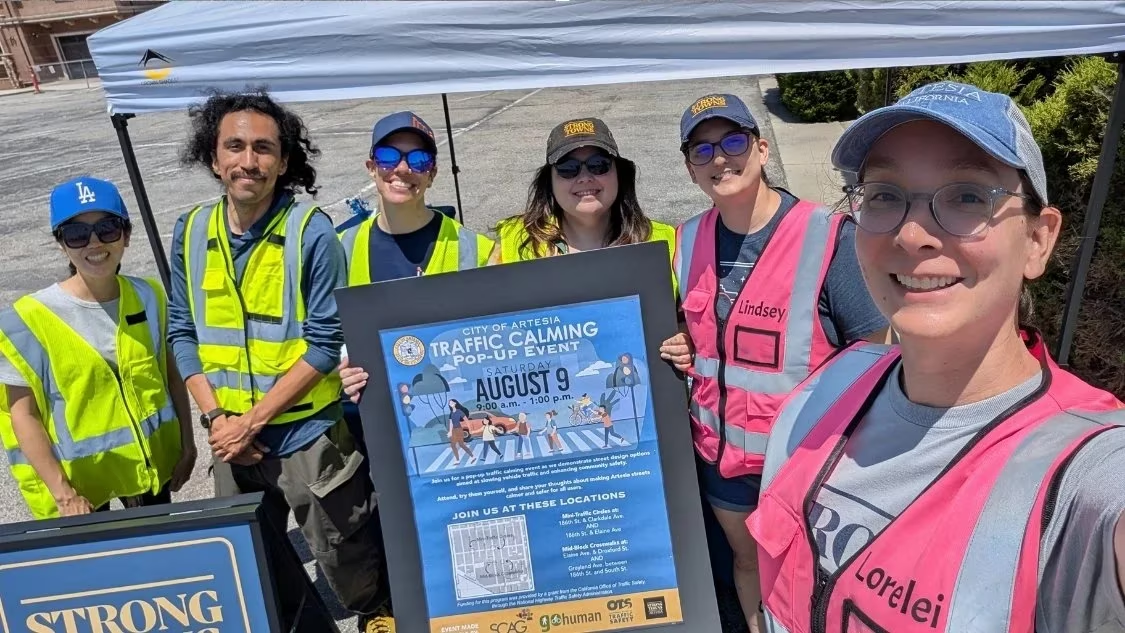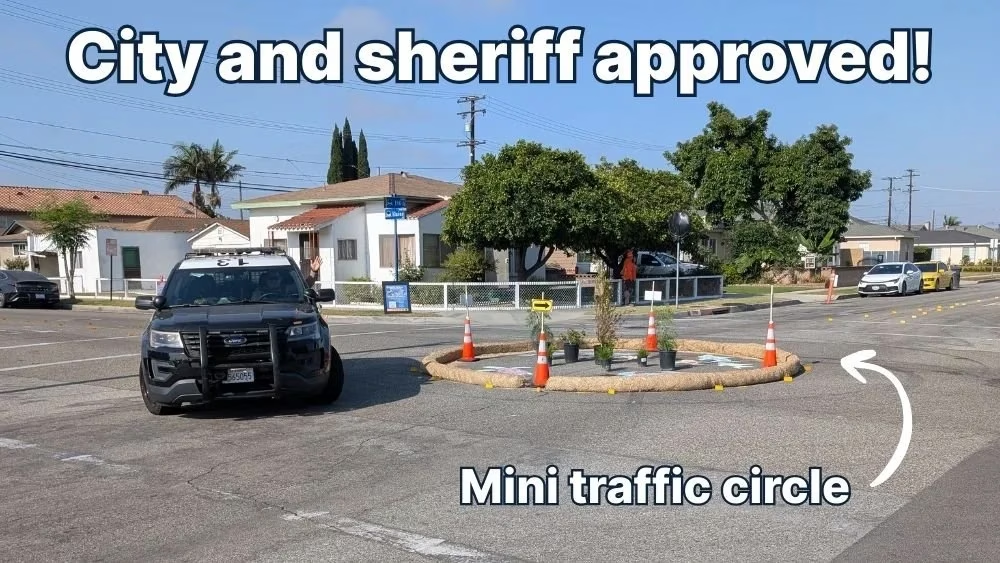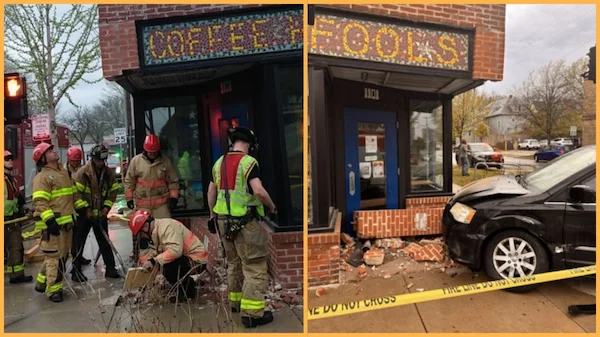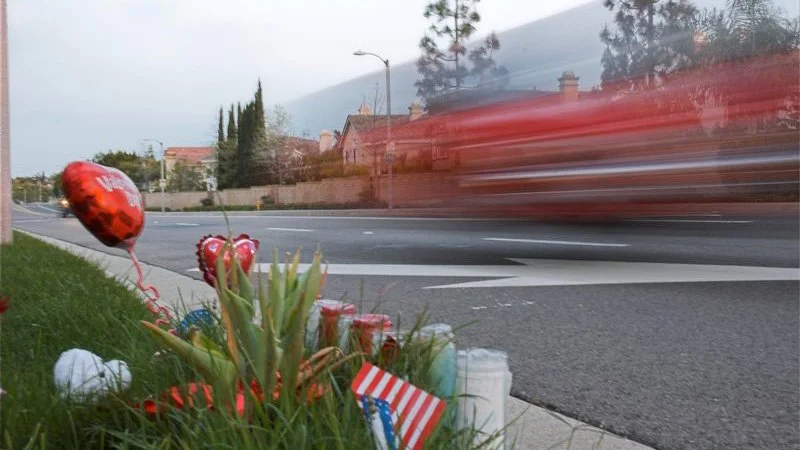Editor's Note: The challenges our cities face are growing, but so is the strength of this movement. Every story we share, every idea we spread, and every tool we build exists because people like you are committed to showing up. Your membership isn’t passive—it’s the momentum that makes change possible.

The city of Artesia, California, has been struggling with a speeding problem. Speeding cars have crashed into numerous houses, totaled parked cars, and driven residents to distraction. Instead of simply blaming drivers for not following the rules, city staff teamed up with the Local Conversation Strong Towns Artesia to change the street design that allowed for speeding in the first place.
On August 9, they held a traffic calming demonstration, testing how design changes might affect driver behavior and giving residents the chance to give input on the redesign. The demonstration included two enhanced crosswalks and — the stars of the demonstration — two mini traffic circles. City staff handled the installation of the circles, using materials they already had on hand like straw wattles, traffic cones, and plants. Local Conversation members helped with public outreach, explaining the project to passersby and gathering feedback through a survey.
During the demonstration project, the average speed of cars dropped to safe residential levels, and outlier speeds also decreased significantly. Survey results showed strong community support: 87% of residents supported the permanent installation of enhanced crosswalks, and 67% supported permanent traffic circles. The project also drew enthusiastic thumbs-up from people driving through, proving that the design changes benefited drivers as well as people on foot.
While the city’s first responders were initially cautious about the redesign, their concerns were quickly assuaged. The Los Angeles Sheriff’s Department was able to navigate the intersection at full response-typical speeds, and a few practice runs proved the design workable even for the fire department’s large trucks.

From idea to implementation, this project only took a few months. A $10,000 grant from the Southern California Association of Governments, along with creative use of existing resources, meant the city could easily cover the costs of materials and staff time. City staff and officials now have valuable data to inform the street redesign, and Strong Towns Artesia’s relationship with the city and residents is stronger than ever.
Many cities struggle to implement this kind of quick, hands-on approach, even when local advocates are ready and willing to partner with officials and staff. So how did Artesia pull off such a success?
The 3 Elements of a Successful Project
“There was a lot of lead-up to making the ground fertile for a project like this,” explained Lorelei Bailey. As the leader of Strong Towns Artesia and chair of the city’s Beautification & Maintenance Commission, she was deeply involved in the project. In fact, she spearheaded the addition of the traffic circles.
Lorelei attributes the success of the project to three things: timing, relationships, and knowledge.
Timing
Roadwork projects are expensive, and most cities don’t have the money to justify an extra redesign. But when the city already has a repaving project planned, it can be easier to get design changes approved. That was the case in Artesia, Lorelei explained. The city had received a California Local Highway Safety Improvement Program (HSIP) grant and was planning a resurfacing project.
The timing was also good in terms of public support. Residents were sick of their property being damaged and their lives put at risk, which made them more likely to accept the suggested changes. If residents hadn’t personally experienced the danger of the status quo, the project likely would’ve faced more resistance.
Relationships
This project is “the result of relationships built up over time with city staff, council members, and other advocates,” Lorelei said. Strong Towns Artesia has been on the scene for a little over a year. In that time, the group has built a reputation for thoughtful and helpful collaboration with city staff and officials, which makes people more inclined to partner with them. In addition, Lorelei’s connections with Strong Towns Artesia and other local organizations helped her spread the word about the project and find volunteers to assist with the demonstration.

Lorelei’s position as commission chair is also helpful in building fruitful relationships. In particular, she highlights her working relationship with Ernesto Sanchez, the city’s public works manager. Ernesto took the repaving project as an opportunity to add enhanced crosswalks to dangerous streets. Knowing that Lorelei had experience with public engagement from leading Strong Towns Artesia, he invited her to join his outreach efforts. When she suggested that the area would benefit from mini traffic circles, he embraced the idea and worked closely with her to bring the project to implementation. Without these connections, it likely would have been much harder to get the project off the ground.
Knowledge
Timing and relationships are vital parts of a successful project, but you also need knowledge to take advantage of them. As Lorelei put it, “You must be able to identify when a project like this is appropriate, clearly communicate the benefits of the project, and be creative in taking advantage of opportunities.”
Lorelei’s knowledge — built over years of advocacy work and her time with the commission — was essential in planning and implementing the traffic calming demonstration. She was able to identify locations where traffic circles were feasible by observing the behavior of drivers. Specifically, she pointed out tire burnout marks in a few intersections where people had been doing donuts. Someone had already tested to see if there was enough room for the traffic circles, she joked.

Lorelei was also able to identify programs and grants that the city could get materials and funding through. She suggested creative ways the city could use resources it already had and helped plan public outreach and feedback collection.
The knowledge of city staff and other local advocates was also key to the project’s success. Ernesto had long been interested in adding traffic circles, so he was familiar with the benefits of implementing them and was able to convince the city engineer that it was a good idea. Local advocates used their knowledge to educate residents and collect useful data.
Putting It Into Practice
Artesia’s traffic calming demonstration proves that, when you do the groundwork of building relationships and knowledge, you’re able to take advantage of opportunities when the time is right. Here are a few ways you could apply this approach in your city:
- Get to know your city staff, elected officials, and local advocacy groups.
- Research local grants and programs.
- Humbly observe your surroundings for clues as to where a project is needed, like the tire burnouts Lorelei spotted.
- Pay attention to what projects the city is planning, so you can identify opportunities when they come.
Do the groundwork now. When the moment comes, you’ll be ready.





